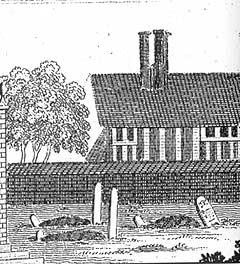 |
 |
 |
 |
 |
 |
 |
 |
 |
 |
 |
 |
 |
 |
 |
 |
 |
 |
 |
 |
 |
 |
 |
 |
 |
 |
Tudor Tour
|
 |
 |
 |
 |
 |
 |
 |
 |
 |
 |
 |
 |
 |
 |
Tudor Manor House
|
 |
 |
 |
 |
 |
 |
 |
 |
 |
 |
 |
 |
 |
 |
 |
 |
The manor house in Willen in Tudor times was an impressive close studded dwelling (high status half timbered house), which survived until around 1800. The 18th century etching gives us a tantalizing glimpse of this impressive building with its tall chimneys, standing next to the churchyard. This building probably replaced an earlier half timbered structure, although we don't know exactly when. [Chimneys were only introduced into the houses of rich people during Tudor times.] A stone wing was added to the north side of the house in the 1500s. |
 |
 |
 |
 |
We don't know if any of the Lords of the Manor actually lived in this house. Willen was always very small and most of the Lords of the Manor owned other, bigger manors as well. It is quite likely that it was mostly occupied by the Lord's steward or one of the more important tenant farmers. Certainly, in the 1700s it was occupied by the tenant farmers Jonathan Abbot and his family. The house was demolished and rebuilt in its present form around 1800. |
 |
 |
 |
This John (Jonathan) Abbott, arrived in Willen c late 1730s, took a lease and probably lived in Manor farm. He must have done well because the Busby Trust let him take on more farmland, and gave him control of the mill and associated lands. They also made him bailiff and gamekeeper for the Busby Estate in Willen. All his children died young, except for William, his second son, who suffered failing sight and was completely blind by 1795, and a daughter who married a local farmer called Williams. When Jonathan died the leases for the farms then passed to kinsmen of his, including his son-in-law. Farmer Williams was still in Manor Farm at the time of the 1822 survey. |
 |









